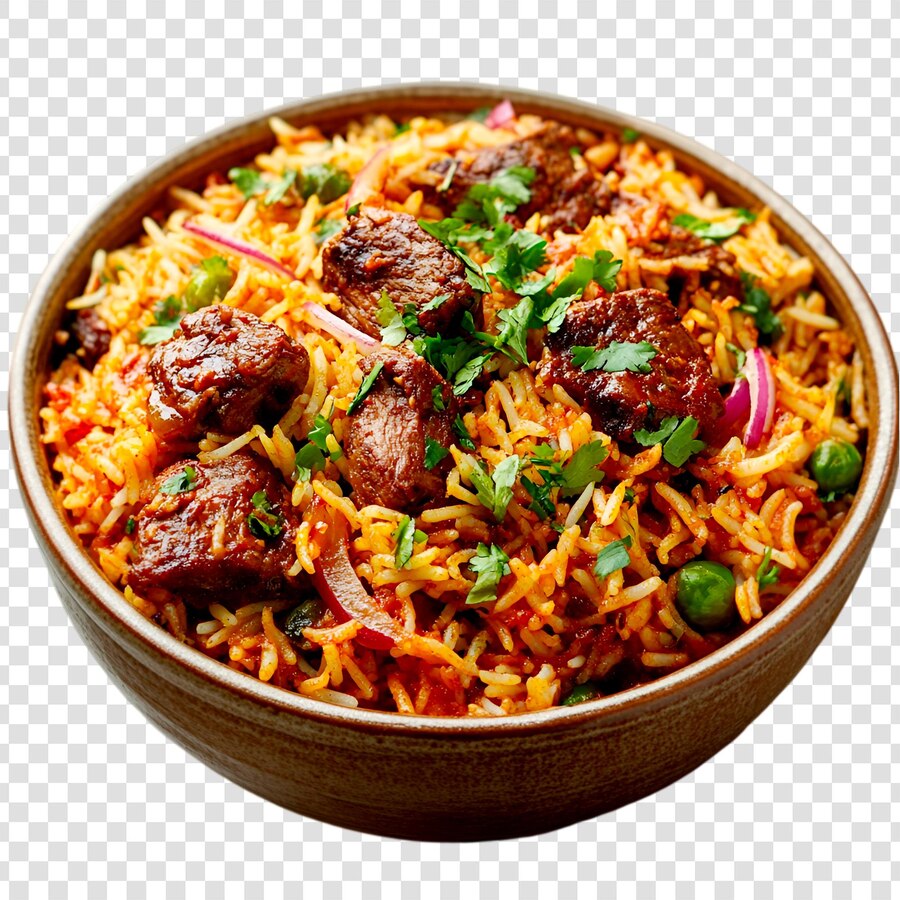Sure! Here’s a detailed, human-written step-by-step guide to making Mutton Biryani, crafted in an engaging and informative style. This version is tailored for blog posts, recipe sites, or personal cooking notes — around 1000 words in length.
How to Make Mutton Biryani – Step-by-Step Guide (Hyderabadi Style)
Mutton Biryani is more than just a dish — it’s a celebration on a plate. Fragrant basmati rice layered with juicy, spice-marinated mutton and slow-cooked to perfection — this classic dish is a must-try for anyone who enjoys rich and flavorful meals.
While it may seem complex, making authentic Hyderabadi-style mutton biryani at home is absolutely doable if you follow the steps carefully. In this guide, we’ll walk you through the full process — marinating the meat, preparing the rice, layering, and cooking it all together in “dum” (steam).
🧾 Ingredients for Mutton Biryani
Let’s divide the ingredients for easier understanding.
For the Mutton Marinade:
-
500g mutton (bone-in, medium pieces)
-
1 cup yogurt (thick curd)
-
2 tbsp ginger-garlic paste
-
1 tsp red chili powder
-
½ tsp turmeric powder
-
1½ tsp biryani masala or garam masala
-
1 tbsp lemon juice
-
Salt to taste
-
1 handful chopped mint leaves
-
1 handful chopped coriander leaves
-
2 green chilies, slit
-
2 tbsp fried onions (optional but adds flavor)
For the Rice:
-
2 cups basmati rice (long grain)
-
6–7 cups water (for boiling)
-
1 bay leaf
-
2 green cardamoms
-
1 black cardamom
-
3 cloves
-
1 small cinnamon stick
-
Salt (1 tbsp for boiling water)
For Biryani Layering and Dum:
-
2 tbsp ghee
-
A few strands of saffron soaked in ¼ cup warm milk
-
2 tbsp fried onions (for topping)
-
Extra mint and coriander for layering
👨🍳 Step-by-Step Guide to Mutton Biryani
Step 1: Marinate the Mutton (Minimum 3 Hours)
-
Wash the mutton pieces well and drain completely.
-
In a large bowl, mix yogurt, ginger-garlic paste, chili powder, turmeric, biryani masala, salt, lemon juice, mint, coriander, green chilies, and fried onions.
-
Add the mutton pieces to this mixture and coat them thoroughly.
-
Cover and refrigerate for at least 3 hours — overnight is even better for deeper flavor.
Why this matters: Long marination tenderizes the mutton and infuses it with spices. Skipping this step often leads to tough, flavorless meat.
Step 2: Prepare the Basmati Rice
-
Rinse the rice in water 2–3 times until the water runs clear. Soak for 30 minutes.
-
Bring a large pot of water to a boil. Add salt, bay leaf, cardamoms, cloves, and cinnamon.
-
Add soaked rice and boil until it’s 70–80% cooked (the grain should break with a bite but not be fully soft).
-
Drain the rice and set it aside. Do not overcook — it will continue cooking during dum.
Pro Tip: Parboiled rice is key. Fully cooked rice will turn mushy when layered with mutton.
Step 3: Layering the Biryani
This is the most exciting part!
-
Take a heavy-bottomed pot or Dutch oven with a tight-fitting lid.
-
Spread the marinated mutton evenly at the bottom.
-
Layer the half-cooked rice on top.
-
Sprinkle saffron milk all over the rice. Add ghee, fried onions, mint, and coriander for added aroma and richness.
-
You can add a dash of kewra or rose water for a restaurant-like touch (optional).
Step 4: Dum Cooking (Slow Steam Method)
-
Seal the pot with foil or place a clean kitchen cloth between the lid and the pot to trap steam.
-
Place the biryani pot on a low flame. Use a tawa (griddle) under the pot if your burner runs hot to prevent burning the bottom.
-
Cook on low for 35–45 minutes.
Signs it’s done: You’ll smell a rich, roasted aroma. The mutton should be fully tender and juicy. The rice should be fluffy and separate, not sticky.
Step 5: Rest and Serve
-
Let the biryani rest (covered) for 10 minutes after turning off the heat.
-
Gently fluff with a flat spoon or fork, mixing a little to distribute the meat but maintaining the layered look.
-
Serve hot with raita, boiled eggs, or salad on the side.
🍽️ Serving Suggestions
-
Onion Raita: Whisk yogurt, sliced onions, green chili, and salt.
-
Mirchi Ka Salan: A spicy green chili curry that pairs perfectly with Hyderabadi biryani.
-
Boiled Eggs: Classic and hearty.
-
Papad & Pickle: Add crunch and tang to your biryani platter.
🔄 Variations You Can Try
-
Kacchi Style Biryani: Where raw marinated mutton is layered with rice and cooked together.
-
Pakki Style Biryani: Where mutton is cooked fully before layering. Great for beginners.
-
Pressure Cooker Biryani: Short on time? Cook everything in one pot with reduced dum time.
-
Spicier Biryani: Add green chili paste or increase red chili powder in the marinade.
🧂 Tips for Perfect Mutton Biryani
-
Use aged basmati rice for best texture and aroma.
-
Marinate well — don’t rush this step.
-
Cook on low heat to prevent burning and allow flavors to meld.
-
Use bone-in mutton — it adds more flavor than boneless cuts.
-
Do not overcook the rice — undercooked rice is better than mushy rice in biryani.
📝 Final Thoughts
Making mutton biryani from scratch is a labor of love. It’s not a quick weekday meal, but it’s definitely worth the time and effort for special occasions, family dinners, or weekend indulgence.
Each step — from marinating the meat to the slow dum cooking — builds layers of flavor. And the aroma that fills your kitchen? Absolutely magical.
Once you master this, you’ll never want to eat restaurant biryani again.
Would you like me to create a downloadable PDF or include a printable version of this recipe for easy use while cooking?


